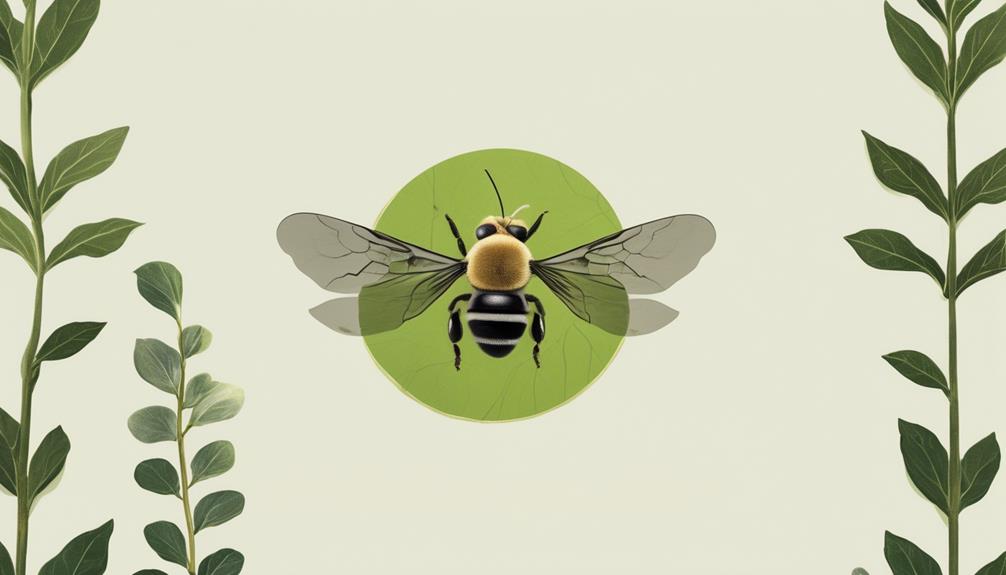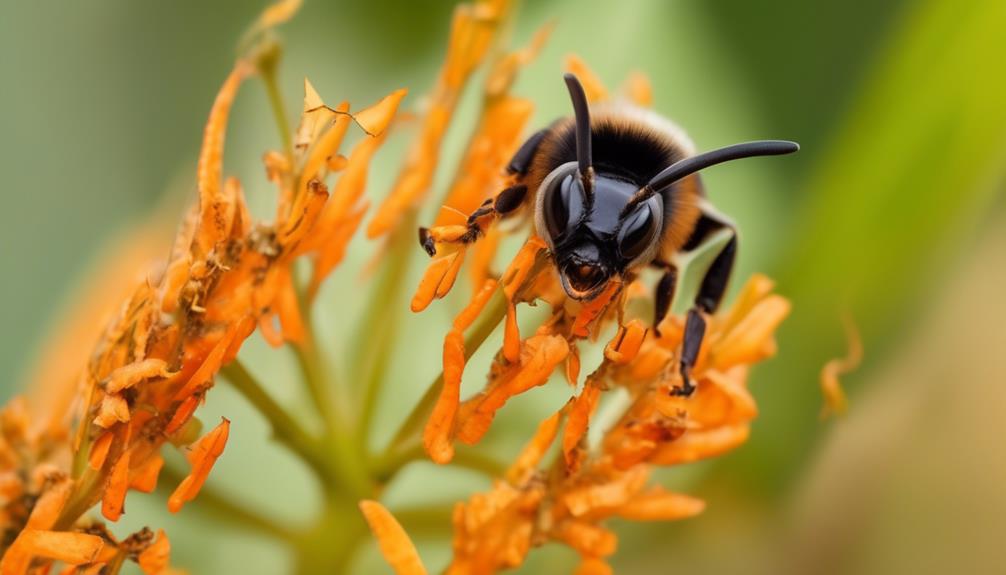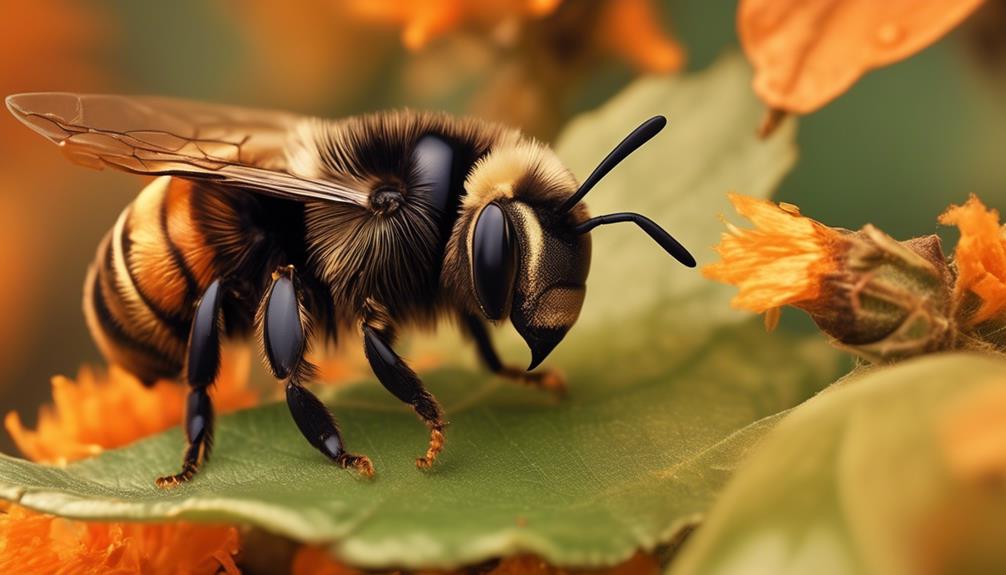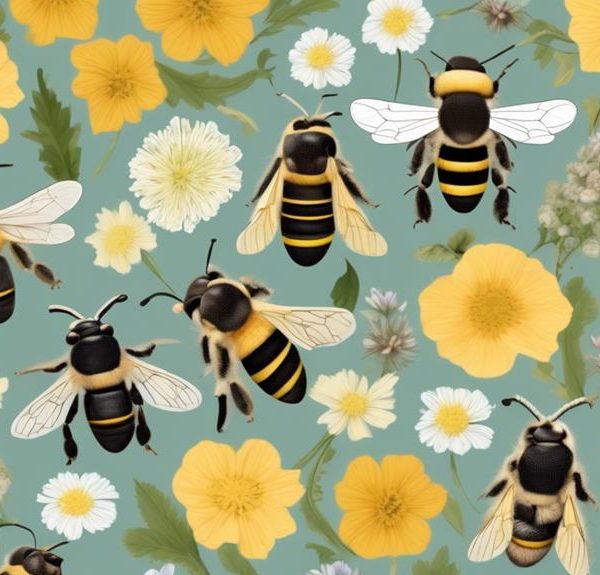Just when you thought you knew bees, discover the fascinating world of leaf cutter bees and how to identify these crucial pollinators in your backyard.

How to Identify Leaf Cutter Bee?
You might not realize it, but those semi-circular notches you've been noticing on the leaves in your garden aren't the work of caterpillars, but are actually the hallmark signs of a leaf cutter bee.
These fascinating creatures can be a challenge to identify, as they're often mistaken for common honeybees. But with a keen eye and a bit of knowledge, you'll soon be able to distinguish these beneficial insects from their more famous counterparts.
In the following discussion, we'll explore the characteristics of leaf cutter bees, their behaviors, and their role in our ecosystem, which is sure to leave you with a newfound appreciation for these hardworking pollinators.
You'll want to stick around for this – the world of leaf cutter bees is truly captivating.
Key Takeaways
- Leaf Cutter Bees are solitary bees that build individual nests and cut precise leaf circles for nest lining or partition.
- They gather pollen on their bellies and mix it with nectar for their larvae.
- Leaf Cutter Bees are more efficient at pollination than honeybees and play a critical role in maintaining plant biodiversity and food security.
- They have physical characteristics such as a metallic blue or green sheen, a stout abdomen with a scopa for leaf transportation, large mandibles with semicircular notches for cutting leaves, and long antennae to detect pheromones.
Understanding Leaf Cutter Bees

To fully grasp the nature of Leaf Cutter Bees, you need to delve into their unique behaviors, ecology, and the vital role they play in our ecosystem. As solitary bees, they don't construct communal hives but rather build individual nests. Intriguingly, they cut precise leaf circles, using them as a nest lining or a partition between brood cells.
Here's a detail you'll find fascinating – Leaf Cutter Bees don't eat these leaves. They gather pollen on their bellies, not their hind legs as most bees do, and mix it into a paste with nectar. They deposit this mixture into the leaf-lined cells for their larvae to feed on. They're diligent and often work at night, making them more efficient than honeybees at pollination.
Their ecological role is indispensable. They're critical in maintaining plant biodiversity and contributing to food security. They're also significant indicators of environmental health, as changes in their population can indicate shifts in habitat quality. Understanding these bees isn't just about knowing their behaviors, but recognizing the vital ecological role they play. It's a testament to the interconnectedness of all life.
Physical Characteristics of Leaf Cutter Bees

Having gained insights into the ecological role and behavioral aspects of Leaf Cutter Bees, you might now be curious about their distinct physical features which set them apart from other bee species.
Leaf Cutter Bees are typically 1/4 to 1/2 inch in length, making them a bit smaller than honeybees. They're marked by a robust body, with a metallic blue or green sheen adding to the allure. They've got a stout abdomen, usually covered in a dense layer of fuzz. This isn't just for show; it's a specialized structure that aids in leaf transportation, called a scopa, which typically exhibits a bright orange or yellow hue.
One of the key identifying characteristics of Leaf Cutter Bees is their mandibles. They're large, sharp, and uniquely tailored for their leaf-cutting behavior. Here, you'll notice semicircular notches, an adaptation that allows them to cut precise circles in foliage. Another noteworthy feature is their antennae, longer in males than in females, which helps them detect pheromones.
Understanding the physical traits of Leaf Cutter Bees isn't just about appreciating their beauty—it's about recognizing their vital role in our ecosystem.
Leaf Cutter Bee Behavior Patterns

Often, you'll find Leaf Cutter Bees displaying a unique set of behavior patterns that distinctly set them apart from other pollinators. These bees are solitary and non-aggressive, predominantly active during daylight hours. They're recognized for their meticulous leaf-cutting behavior, where they use their sharp mandibles to cut circular or oval pieces from leaves and petals. This activity isn't intended to harm the plant, but to gather material for their nests.
What's fascinating is that these bees display exceptional navigational skills. Despite their solitary nature, they can locate their nests with precise accuracy, often across considerable distances. They also exhibit a unique flight pattern, hovering in a circular motion before landing on the foliage they intend to cut.
Another distinctive trait is their pollination method. Unlike honeybees who carry pollen on their hind legs, Leaf Cutter Bees carry pollen on their abdomen. This results in more efficient pollination since the pollen has direct contact with the stigma of flowers.
Understanding these behavior patterns won't only help you identify Leaf Cutter Bees, but also appreciate their role in maintaining the health and diversity of our ecosystems. So the next time you spot a bee with a chunk of leaf, you'll know exactly who you're looking at.
Habitat and Distribution of Leaf Cutter Bees

While you might spot Leaf Cutter Bees in your garden, it's essential to understand that their habitat and distribution are far more extensive. These bees are found globally, with a concentration in the warmer, temperate regions of North and South America. They're less common in colder climates, due to their preference for warm environments.
Leaf Cutter Bees make their homes in varied locations, from the ground, in rotting wood, to your garden plants. They're solitary creatures, meaning they don't live in colonies like other bees. Female Leaf Cutter Bees take on the role of homemakers, creating nests for their offspring.
When it comes to their distribution, it's influenced by the availability of vegetation. These bees are vegetarians, cutting leaves to use in their nests. So, you'll often find them in areas abundant in plant life. They're an adaptable species, making their presence known even in urban settings with enough greenery.
Role in the Ecosystem and Importance

Beyond their intriguing habits and global distribution, Leaf Cutter Bees play a crucial role in the ecosystem, underscoring their importance to our planet's balance. These solitary bees are excellent pollinators, often outperforming other bee species. They're pivotal to promoting biodiversity, ensuring the successful reproduction of plants.
You'll find their impact in gardens and agricultural settings. Leaf Cutter Bees contribute to the growth of fruits, vegetables, and flowers, directly affecting the food chain. Your everyday meal might not be possible without their diligent pollination work.
Let's delve into a detailed examination of their role:
Role | Impact | Emotional Response |
|---|---|---|
Pollination | Promotes plant reproduction | Admiration for their efficiency |
Biodiversity Promotion | Supports a variety of life forms | Appreciation for their contribution |
Agricultural Contribution | Assists in food production | Gratitude for their indirect provision |
Ecosystem Balance | Ensures natural order | Respect for their essential role |
Insect Population Control | Preys on harmful insects | Relief for their protective duty |
Conclusion
In conclusion, identifying leaf cutter bees isn't rocket science. Look for their distinctive physical traits and unique leaf-cutting behavior.
They're widespread, found in diverse habitats, playing a critical role in our ecosystem. Understanding and appreciating these bees is crucial; they're vital pollinators, ensuring our plants bloom.
So, next time you see a bee carrying a leaf piece, remember, you're witnessing a leaf cutter bee at work.


